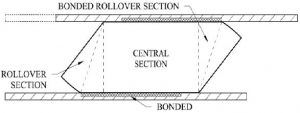Seismic mitigation using a novel elastomeric isolator

Tech ID
12-064
Inventors
M. Tait
Patent Status
US Patent 9429205
CA Patent 2864006
Stage of Research
Proof of principle complete and tested
Technology is being optimized for various seismic conditions
Publications
- Partially Bonded Fiber Reinforced Elastomeric Insolators (PB-FREIs)
Further Information
Date Released
21 January 2016
Contact
Paul Grunthal
Business Development Manager
Abstract
Studies of past earthquakes, especially in developing countries, have shown that numerous deaths are often attributed to the collapse of poorly constructed housing. If the level of seismic demand, imposed on these buildings, was reduced through a simple but reliable base isolation technique, fewer buildings would fail and fewer lives would be lost. Researchers at McMaster University’s Department of Civil Engineering have developed a prototype isolator to effectively mitigate the effects of earthquakes on low-rise buildings in high seismic regions.
This invention bridges the gap between a traditionally fully bonded elastomer bearing and an unbonded elastomeric isolator. Recent research has demonstrated the effectiveness of an unbonded fiber reinforced elastomeric isolator. However, unlike a fully bonded elastomeric isolator an unbonded isolator cannot resist any (uplift) tensile forces. Similar to a stable unbonded fiber reinforced elastomeric isolator, a partially bonded bearing still exhibits a reduction in horizontal stiffness when displaced laterally. In addition, the partial bond between the bearing and the contact surfaces allows the isolator to resist (uplift) tensile forces. Finite element simulations have confirmed the response characteristics of a partially bonded bearing.
Results confirm the feasibility of this novel base isolation technique for hazard mitigation of low-rise buildings located in high-seismic regions worldwide.
Applications
- Seismic mitigation solution for low-rise buildings
- Suitable for other structures including masonry buildings,
bridges, etc.
Advantages
- Superior performance and efficiency when compared to fully-bonded bearings
- Can resist (uplift) tensile forces unlike its bonded couterparts
- Transfers tensile forces to potentially eliminate the need of tie downs or restraints

